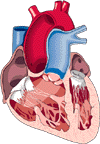
A L L A B O U T T H E H E A R T

For all of its medical complexity and poetic imagery, the heart is "just a pump", or two pumps to be exact. The left side, takes "fresh" blood from the lungs and pumps it out through the aorta to the rest of the body. The cells of the body use oxygen and other nutrients in the blood and deposit wastes it no longer wants. The blood goes back through veins to the "right side" of the heart, where it is pumped to the lungs again . . . and the whole process begins again.
The heart is divided into these two sides to keep the two types of blood (that with a fresh supply of oxygen and that which has already been used) from mixing. Each side has an upper half (the atrium) which works as a "priming pump" to fill the much stronger lower half (the ventricle) which does the harder pumping. The right ventricle pumps to the lungs, which is a relatively small amount of tissue. The left ventricle must pump to the rest of the body, and is the most important chamber of the heart.
Four valves are present to prevent blood from going back into the chamber from which it just came from. The closing of these structures is what makes the familiar "lub-dub" which can be heard with the stethoscope. Leakage or blockage of these structures can cause significant problems.
Despite the blood that goes right through the heart chambers, the heart muscle itself does not obtain any nutrients directly from this source. It receives this blood from the coronary arteries. Blockage of these vessels are associated with heart attacks and other important heart conditions. [ Coronary Artery Disease ]
In order to maintain order, the heart has an electrical system which coordinates the action of each of the chambers to fire at the right time. This electrical activity may occur too quickly or too slowly, or have "short circuits" set up.
The muscle is called the "myocardium", the inside layer the "endocardium", and the heart is lined with a thin layer of tissue called the "pericardium".
Explore other parts of HeartPoint to learn more about the heart, its diseases and their treatment.
Some interesting facts:
- The heart is about the size of your fist.
- It generally only pumps about 50% of the blood which is in the chamber at the beginning of its pumping phase (this is called the "ejection fraction").
- It generally pumps about 5 quarts a minute.
- It can pump up to about 5 gallons a minute with exercise.
- It pumps about 4000 gallons of blood each day.
©COPY;1997 HeartPoint Updated July 1997
| Commentary | Food You Will Love | HeartPoint Gallery | In The News | Health Tips | What's New
| Information Center | Home |This site presents material for your information, education and entertainment. We can assume no liability for inaccuracies, errors, or omissions. Above all, material on this site should not take the place of the care you receive from a personal physician. It is simply designed to help in the understanding of the heart and heart disease, and not as a diagnostic or therapeutic aid. You should seek prompt medical care for any specific health issues. Please feel free to browse the site and download material for personal and non-commercial use. You may not however distribute, modify, transmit or reuse any of these materials for public or commercial use. You should assume that all contents of the site are copyrighted. ©COPY;1997 HeartPoint